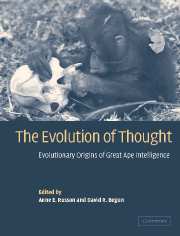Book contents
- Frontmatter
- Contents
- List of Contributors
- Preface
- 1 Evolutionary reconstructions of great ape intelligence
- 2 Enhanced cognitive capacity as a contingent fact of hominid phylogeny
- PART I COGNITION IN LIVING GREAT APES
- PART II MODERN GREAT APE ADAPTATION
- PART III FOSSIL GREAT APE ADAPTATIONS
- Introduction
- 13 Paleoenvironments and the evolution of adaptability in great apes
- 14 Cranial evidence of the evolution of intelligence in fossil apes
- 15 Life history and cognitive evolution in the apes
- 16 Fossil hominoid diets, extractive foraging, and the origins of great ape intelligence
- 17 Paleontology, terrestriality, and the intelligence of great apes
- 18 Body size and intelligence in hominoid evolution
- Part IV INTEGRATION
- Author index
- Species index
- Subject index
18 - Body size and intelligence in hominoid evolution
Published online by Cambridge University Press: 20 August 2009
- Frontmatter
- Contents
- List of Contributors
- Preface
- 1 Evolutionary reconstructions of great ape intelligence
- 2 Enhanced cognitive capacity as a contingent fact of hominid phylogeny
- PART I COGNITION IN LIVING GREAT APES
- PART II MODERN GREAT APE ADAPTATION
- PART III FOSSIL GREAT APE ADAPTATIONS
- Introduction
- 13 Paleoenvironments and the evolution of adaptability in great apes
- 14 Cranial evidence of the evolution of intelligence in fossil apes
- 15 Life history and cognitive evolution in the apes
- 16 Fossil hominoid diets, extractive foraging, and the origins of great ape intelligence
- 17 Paleontology, terrestriality, and the intelligence of great apes
- 18 Body size and intelligence in hominoid evolution
- Part IV INTEGRATION
- Author index
- Species index
- Subject index
Summary
INTRODUCTION
Great apes and humans are the largest-brained primates. Aside from a few extinct subfossil lemurs, they are also the largest in body mass. Body size is a key aspect of a species' biology, a large organism having different energetic, ecological, and physical constraints than a small one. Brain size, in so far as it determines abilities to acquire, process, and act on information, is also a key aspect of a species' biology and is linked to body size. Large animals have different informational problems to solve than do small ones, hence their respective sensory organs and nervous systems are sized and organized differently.
Mammalian body and brain size scale consistently with each other (Figure 18.1). This relation is generally described by allometric exponents that vary between 2/3 and 3/4 (e.g., Bauchot & Stephan 1966, 1969; Hofman 1982; Jerison 1973; Lande 1979; Martin 1981; Martin & Harvey 1985; Stephan 1972). From a paleontological perspective, the body–brain size relation offers an appealing way to evaluate the cognitive abilities of fossil taxa, a problem of particular importance for understanding hominid evolution.
A convincing theoretical basis for this general allometric statistical pattern, however, remains elusive (Deacon 1997; Harvey & Krebs 1990). Body mass is not a strict determinant of brain size, as species of similar size can have different brain sizes and cognitive abilities (Pagel & Harvey 1989).
- Type
- Chapter
- Information
- The Evolution of ThoughtEvolutionary Origins of Great Ape Intelligence, pp. 335 - 350Publisher: Cambridge University PressPrint publication year: 2004
- 4
- Cited by



